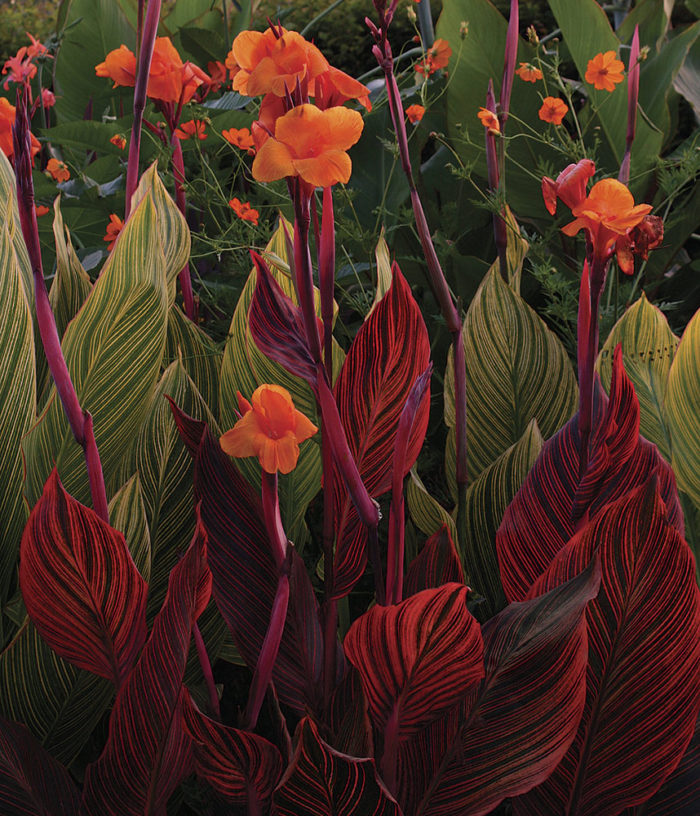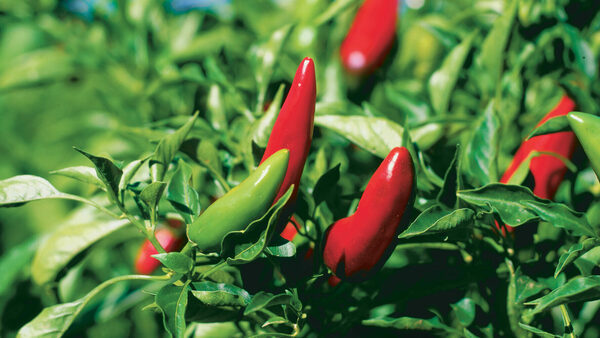
Dennis Schrader has a gift for using hot colors in the landscape. Landcraft Environments, the wholesale nursery that he co-owns with Bill Smith, in Mattituck, New York, grows an inspiring array of charismatic tropical and annual plants. Dennis combines their bold forms and exuberant colors in garden beds and containers, with dazzling results.
These incandescent compositions dispel the myth that hot hues are best used only in small doses. Masses of vivid leaves and blooms harmonize beautifully in Dennis’s hot-color combinations because of his mindful approach to color and composition.
Each of his designs is based around a carefully coordinated palette of hot hues and accent colors. By repeating a color theme among multiple plants and incorporating a diverse array of leaf and flower textures, Dennis achieves an effect that is both energetic and orderly.

Real-world palettes inspire fresh color combinations
When developing a hot new color combination, Dennis’s practiced eye seeks out real-world situations where key colors that he wants to use look their best. “Inspiration can come from anywhere,” he says. A great color combo could show up in fabric on the fashion runway, from graffiti sprayed on the side of a subway car, or in the glowing embers of a summer sunset.
Dennis closely observes the tints, tones, and contrasting hues that accompany his key colors. Oranges, reds, or yellows might be the major players, but he finds that the more subtle colors, like garnet, salmon, champagne, and chartreuse, are the ones that tie his designs together. He also seeks out dark or contrasting tones to add visual weight and balance.

Color repetition provides continuity
Finding the best plants to express a hot-color theme requires both discipline and artistry. Multiple shades of the same hot hue can be overwhelming. A limited palette of colors that are picked up by multiple plants lends a sense of order.
Dennis deftly works broad brushstrokes and sparkling highlights of his chosen colors throughout a design. This strategy helps tie the design together and allows him to integrate a diverse tapestry of leaf and flower textures.
Leaves contribute color and texture
A hot-color plant combination needs more than just colorful blooms to be successful, and foliage is an important component in Dennis’s designs. Leaves contribute key hues before blooms emerge and after they fade, and foliage colors and shapes are carefully chosen to complement the overall design.
Even leaves that are primarily green can add tints of gold, bronze, blue, or red to a hot-color palette. Foliage with reddish overtones provides a subtle color echo for brighter reds or a warm backdrop for other luminous hues. Leaves laced with pale yellow or chartreuse pick up the brightness of sunny yellows and golds.
Dennis often incorporates foliage that is very light or very dark to his hot-color combinations. A light-reflecting mass of silvery leaves is a refreshing frosty contrast to fiery hues. Leaves that are almost black give the eye a place to rest, and they increase the star power of brilliant saturated colors nearby.
DESIGN TIPS

- Blazing sunset hues: Annual black-eyed Susan (Rudbeckia hirta ‘Prairie Sun’, annual) and cannas (Canna ‘Pretoria’ and Tropicanna® Canna indica ‘Phasion’, Zones 8–11, also pictured at the top of this article) offer brilliant, flame-colored blooms and an abundance of dramatic texture.
- Deep, warm reds: Burgundy leaves are a perfect foil for hot hues. ‘Red Spires’ castor bean (Ricinus communis ‘Red Spires’, annual) and a dark-leaved dahlia (Dahlia ‘Bishop of Llandaff’, Zones 8–11) combine sultry foliage with red flowers.
- A shimmer of silver: With hot golden flowers and frosty foliage, Japanese silver-leaf sunflower (Helianthus argophylus, annual) provides both a color echo and some cool contrast for its hot-colored companions.
Containers put hot colors wherever needed
Containers and hanging baskets are a great way to introduce sizzling hues to decks, patios, or even indoor spaces. Dennis uses artistically arranged container groupings with just one or two varieties per pot to break away from the spiller/thriller/filler mantra.
Again, he chooses colors carefully, repeats them within the composition, and uses a mix of foliage textures for visual interest.
Container groupings are easily recombined and rearranged. So if you want to try out a new color scheme without redesigning a garden bed, a collection of planters might be the design laboratory you are looking for.

Are you ready to bring some blazing color into your own garden beds and containers? Follow Dennis’s example: Be strategic, be creative, and be bold. The world around us is filled with gorgeous hot-color combinations. Find one that inspires you, and use it to heat up your next garden design.
—Carol Collins is an assistant editor.
Photos, except where noted: Lynn Felici-Gallant
Fine Gardening Recommended Products

A.M. Leonard Deluxe Soil Knife & Leather Sheath Combo
Fine Gardening receives a commission for items purchased through links on this site, including Amazon Associates and other affiliate advertising programs.

Gardener's Log Book from NYBG
Fine Gardening receives a commission for items purchased through links on this site, including Amazon Associates and other affiliate advertising programs.

Buffalo-Style Gardens: Create a Quirky, One-of-a-Kind Private Garden with Eye-Catching Designs
Fine Gardening receives a commission for items purchased through links on this site, including Amazon Associates and other affiliate advertising programs.



















Comments
Log in or create an account to post a comment.
Sign up Log in